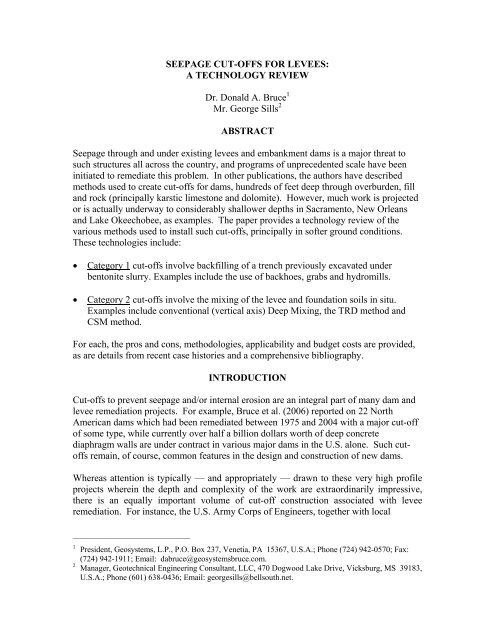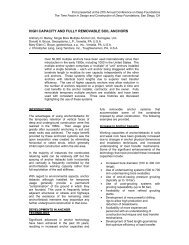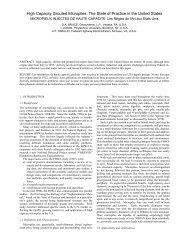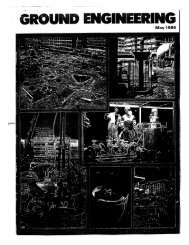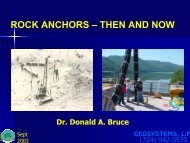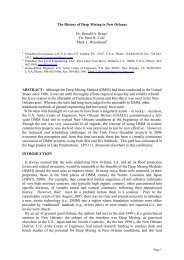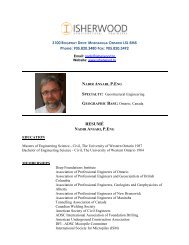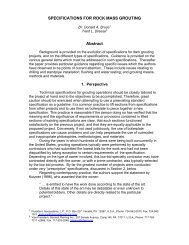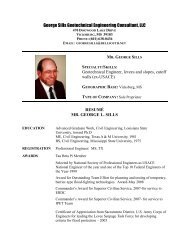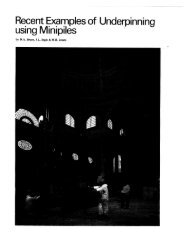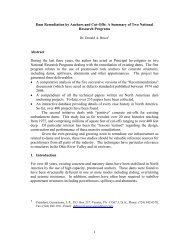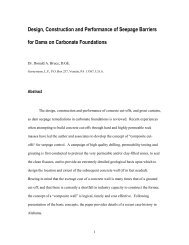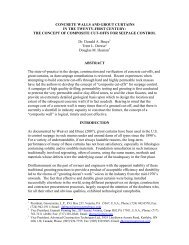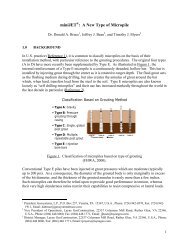SEEPAGE CUT-OFFS FOR LEVEES: A ... - Geosystems, L.P.
SEEPAGE CUT-OFFS FOR LEVEES: A ... - Geosystems, L.P.
SEEPAGE CUT-OFFS FOR LEVEES: A ... - Geosystems, L.P.
Create successful ePaper yourself
Turn your PDF publications into a flip-book with our unique Google optimized e-Paper software.
<strong>SEEPAGE</strong> <strong>CUT</strong>-<strong>OFFS</strong> <strong>FOR</strong> <strong>LEVEES</strong>:<br />
A TECHNOLOGY REVIEW<br />
Dr. Donald A. Bruce 1<br />
Mr. George Sills 2<br />
ABSTRACT<br />
Seepage through and under existing levees and embankment dams is a major threat to<br />
such structures all across the country, and programs of unprecedented scale have been<br />
initiated to remediate this problem. In other publications, the authors have described<br />
methods used to create cut-offs for dams, hundreds of feet deep through overburden, fill<br />
and rock (principally karstic limestone and dolomite). However, much work is projected<br />
or is actually underway to considerably shallower depths in Sacramento, New Orleans<br />
and Lake Okeechobee, as examples. The paper provides a technology review of the<br />
various methods used to install such cut-offs, principally in softer ground conditions.<br />
These technologies include:<br />
• Category 1 cut-offs involve backfilling of a trench previously excavated under<br />
bentonite slurry. Examples include the use of backhoes, grabs and hydromills.<br />
• Category 2 cut-offs involve the mixing of the levee and foundation soils in situ.<br />
Examples include conventional (vertical axis) Deep Mixing, the TRD method and<br />
CSM method.<br />
For each, the pros and cons, methodologies, applicability and budget costs are provided,<br />
as are details from recent case histories and a comprehensive bibliography.<br />
INTRODUCTION<br />
Cut-offs to prevent seepage and/or internal erosion are an integral part of many dam and<br />
levee remediation projects. For example, Bruce et al. (2006) reported on 22 North<br />
American dams which had been remediated between 1975 and 2004 with a major cut-off<br />
of some type, while currently over half a billion dollars worth of deep concrete<br />
diaphragm walls are under contract in various major dams in the U.S. alone. Such cutoffs<br />
remain, of course, common features in the design and construction of new dams.<br />
Whereas attention is typically — and appropriately — drawn to these very high profile<br />
projects wherein the depth and complexity of the work are extraordinarily impressive,<br />
there is an equally important volume of cut-off construction associated with levee<br />
remediation. For instance, the U.S. Army Corps of Engineers, together with local<br />
_____________________________<br />
1 President, <strong>Geosystems</strong>, L.P., P.O. Box 237, Venetia, PA 15367, U.S.A.; Phone (724) 942-0570; Fax:<br />
(724) 942-1911; Email: dabruce@geosystemsbruce.com.<br />
2 Manager, Geotechnical Engineering Consultant, LLC, 470 Dogwood Lake Drive, Vicksburg, MS 39183,<br />
U.S.A.; Phone (601) 638-0436; Email: georgesills@bellsouth.net.
partners has, for almost two decades, been remediating the levees in Sacramento, the<br />
work at Herbert Hoover Dike, around Lake Okeechobee in Florida, is now fully<br />
underway, while equally ambitious projects are imminent in New Orleans. Cut-offs for<br />
levees are typically shallower than those for dams, for obvious reasons associated with<br />
the height of the levee itself and the nature of the foundation materials: there is no call to<br />
penetrate one or two hundred feet of embankment material and then continue for another<br />
hundred feet into rock, often both hard and abrasive on the one hand, and containing<br />
massive karstic features on the other. However, the engineering requirement for a levee<br />
cut-off to have acceptable permeability, strength, deformability, homogeneity, continuity<br />
and durability does present challenges to the engineering community, especially when it<br />
is borne in mind that although such cut-offs are typically less than 100 feet in depth, they<br />
may well extend laterally for thousands of feet.<br />
The purpose of this paper is to provide a comparative review of the various technologies<br />
which are being used, or can be foreseen to be used, to construct cut-offs through levees.<br />
There are many ways to classify and present these technologies, and the authors have<br />
decided to follow a very simple, albeit unorthodox framework:<br />
• Category 1 cut-offs are created by backfilling a previously excavated trench,<br />
supported by bentonite slurry.<br />
• Category 2 cut-offs are created by mixing the levee and foundation soils in situ.<br />
Regarding Category 1, most levee cut-off work is conducted in a continuous laterally<br />
progressive fashion by backhoe. However, where there are particular geological or<br />
technical challenges, then excavation by grabs (clamshells) in an interconnected sequence<br />
of discrete panels is undertaken. In extreme ground conditions, rock milling technology<br />
may be required but, as is quantified below, this will markedly influence the cost of the<br />
work.<br />
The oldest method under Category 2 is the conventional Deep Mixing Method (DMM)<br />
using vertical mixing augers equipped with mixing blades. More recently, the goal of<br />
producing a high quality “soilcrete” in situ has been addressed by two new technologies,<br />
namely the Japanese TRD (Trench Remixing and Cutting Deep) Method, and the French-<br />
German CSM (Cutter Soil Mix) Method and its Italian sister, CTJet.<br />
This paper provides a guide to these various methods. Excluded from the review are<br />
Category 1 walls constructed by secant piles (e.g., as at Beaver Dam, AR in 1992-1994 as<br />
described by Bruce et al., 1996) since they simply would not be cost competitive in a<br />
levee situation, and grouted cut-offs, which are described elsewhere (Bruce et al., 2008)<br />
and are not technically suited to levee conditions and economics.
General Comment<br />
CATEGORY 1 <strong>CUT</strong>-<strong>OFFS</strong> (EXCAVATION AND BACKFILL)<br />
The intrinsic advantage of such walls is that the resultant cut-off material (i.e., the<br />
“backfill”) can be engineered to provide an extremely wide range of properties,<br />
independent of the native material through which the cut-off has been excavated. This<br />
ability is so fundamental that the actual cut-offs are primarily called after the materials<br />
themselves, as opposed to the method of excavation:<br />
• conventional concrete walls<br />
• plastic concrete walls<br />
• cement-bentonite walls (CB)<br />
• soil-bentonite walls (SB)<br />
• soil-cement-bentonite walls (SCB)<br />
Bearing in mind that, to the authors’ knowledge, conventional concrete walls are not<br />
required and would not be economically feasible in levee remediation, then the following<br />
matrix summarizes the relationship between excavation technique and backfill type.<br />
In all cases except CB walls, excavation is conducted under bentonite slurry which is<br />
thereafter displaced out of the trench or panel by the backfill material of choice. It is<br />
generally believed that the concept of excavating under a bentonitic supporting slurry was<br />
first developed by Veder, in Austria, in 1938.<br />
TYPE OF<br />
BACKFILL<br />
EXCAVATION METHOD<br />
CLAMSHELL HYDROMILL BACKHOE<br />
Plastic Concrete Feasible Feasible Not conducted<br />
CB Relatively Common Feasible Common<br />
SB Not conducted Not conducted Very common<br />
SCB Rare Rare Very common<br />
Excavation Methods<br />
Details of the various excavation methods are provided in older fundamental texts such as<br />
Xanthakos (1979) and ASTM (1992), while Bruce et al. (2006) summarize case histories<br />
of more recent vintage. Much valuable information may also be obtained in the websites<br />
of the major contractors and equipment manufacturers. The following notes are provided<br />
by way of introduction, and perspective.<br />
It is often the case that all three techniques may be used on the same project: the backhoe<br />
to excavate a “pre-trench,” say 20-40 feet deep, the clamshell to excavate through<br />
unobstructed fill or soil, and the hydromill to cut into the underlying or adjacent rock.<br />
Clamshell
The technology was first practiced by Rodio on a project at Bondeno on the River Po in<br />
Italy in 1953 and quickly spread throughout Europe as a very adaptable method for<br />
constructing deep foundation systems. The first Canadian application was in 1957 and<br />
the first use in the U.S. was in 1962. The first example for dam remediation appears to<br />
have been the seminal project at Wolf Creek Dam, KY between 1975 and 1979. This<br />
was in fact a combination of rotary drilling and clamshell excavation.<br />
Clamshells (excavating buckets) can be cable suspended or kelly-mounted, mechanical or<br />
hydraulic. They are used to excavate panels 16 to 66 inches wide, to maximum depths of<br />
about 250 feet depending on the choice of crane. Most cut-offs are 24 to 36 inches wide<br />
and less than 150 feet deep. One “bite” is typically 6 to 10 feet long, and Primary panels<br />
may consist of one to three bites (Figure 1). The intervening Secondary panel is most<br />
typically installed in one bite, with special attention required to assure the cleanliness and<br />
integrity of the inter panel joints.<br />
Hydromills<br />
Figure 1. Concrete and plastic concrete slurry wall construction in panels<br />
(Millet et al., 1992).<br />
Hydromills, or “cutters” evolved from earlier Japanese and European reverse circulation<br />
excavating equipment in the late 1970s. Developed principally by Soletanche, Rodio,<br />
Casagrande and Bauer, these machines basically consist of a large rigid frame housing 2<br />
pairs of cutting wheels set below a high capacity reverse circulation suction pump (Figure<br />
2). Such machines are best suited for excavating very deep walls toed considerable<br />
distances into bedrock, for cutting through especially resistant horizons, and for assuring<br />
efficient tie-in into very steep valley sections or existing concrete structures. Due to their<br />
high cost of operation, their use is typically not competitive in the conditions prevalent on<br />
most levee repairs . As detailed in Bruce et al. (2006), hydromills had been used on nine<br />
major dam remediations between 1984 (St. Stephens Dam, SC) and 2005 (Mississenewa,<br />
IN) for a combined total area of almost 2.4 million square feet. Wall thicknesses range<br />
from 24 to 60 inches with most being in the range of 33 to 39 inches. The maximum<br />
depth of just over 400 feet was recorded at Mud Mountain Dam, WA in 1990. Short, one<br />
bite Secondary panels (6-10 feet wide) are typically used to mate at least 4 inches into the
Figure 2. Hydromill being extracted from trench, at Herbert Hoover Dike, FL<br />
(Courtesy of TreviICOS South).<br />
larger, three bite (18-26 feet wide) Primaries. Recent developments allow the hydromill<br />
to be guided in real time to assure deviations from verticality considerably less than 1%<br />
of depth.<br />
Backhoes<br />
According to Xanthakos (1979), the first slurry trench cut-off was “probably” built at<br />
Terminal Island, near Long Beach, CA in 1948. It was 45 feet deep and backfilled with<br />
soil. Ryan and Day (2003) reported that “thousands” of such walls have been built in the<br />
U.S. since the early 1970s, predominately backfilled with soil-bentonite. The technique<br />
is fundamentally very simple: a long reach bucket excavator (backhoe) is used to dig a<br />
long slot in the soil (Figure 3) which is supported by bentonite slurry. Backfilling with<br />
SB or SCB is conducted progressively, with reuse of the excavated soil(s) always<br />
preferred if at all possible, for simplicity as well as economy. Most often the backfill is<br />
prepared by dozers and other earthmoving equipment on the surface adjacent to the<br />
trench, or in some type of containment “box,” and pushed into the trench where it<br />
typically adopts an angle of repose of about 1 vertical to 6 horizontal. On certain projects,<br />
a pugmill mixing and blending system is specified, and trucking of the backfill material
Figure 3. Typical arrangement of a backhoe wall<br />
(Soletanche Promotional Information).<br />
to the trench may be required, together with tremie placement. Where CB is used, of<br />
course, its dual purpose is to support the excavation and then to harden in place as the<br />
backfill material. For SC and SCB walls, good technique involves bringing the toe of the<br />
backfill close up to the excavated face after completion of the day’s work. The following<br />
morning, the bottom of the trench is “cleaned” (most effectively by the excavator) and a<br />
portion (say 2-5 feet) of the previous day’s backfill dug out of the trench to assure that no<br />
highly permeable “stripes” of settled sediment are left in situ. It is typical to require a 50-<br />
to 150-foot separation between backfill toe and base of excavation slope during routine<br />
work, although there seems little engineering logic for this.<br />
Most backhoe cut-offs for dams and levees have been 30-36 inches wide and not more<br />
than 60 feet deep. However, recent developments have pushed maximum “comfortable”<br />
depths to around 75 feet, while equipment has been developed to excavate to over 100<br />
feet in favorable conditions.<br />
Backfill Materials and Properties<br />
The authors recommend that detailed guidance for the design and performance of the<br />
various types of backfill mixes be obtained primarily from the classic texts, as referenced<br />
above (and especially Millet et al., 1992), and from the other case history specific<br />
accounts referenced in Bruce et al. (2006). As general background, however, the<br />
following summary is provided.<br />
CB (Self-Hardening Cement-Bentonite)<br />
There is a very wide range in the relative components of these mixes, but in general such<br />
mixes can be expected to comprise 3-4% bentonite and 15-30% cement. It is common to<br />
include a retarder, while it is often overlooked that the mix in situ may well contain up to<br />
10% or more of the native soil. An example of a mix used by Trevi as a “plastic” cut-off<br />
for a dam in North Africa comprised:<br />
– Bentonite: 45-50 kg/m 3 of mix<br />
– Cement: 200-230 kg/m 3 of mix<br />
– Water: 900-950 kg/m 3 of mix
This provided:<br />
• k < 10 -6 cm/s, decreasing further to 10 -7 cm/s and less with time;<br />
• UCS ≥ 100 psi;<br />
• Strain at failure: 1-2%.<br />
Excellent background on specific projects has also been provided by Khoury et al. (1989),<br />
Hillis and Van Aller (1992) and Fisher et al. (2005). Blast furnace slag is proving to be a<br />
popular substitution for significant weights of Portland cement, especially where<br />
relatively low strength and long setting times are required.<br />
Typical mixes which have been used recently include:<br />
• Project A<br />
– Water: 400 kg/m 3 of mix<br />
– Bentonite: 30 kg/m 3 of mix<br />
– Cement 150 kg/m 3 of mix<br />
– Sand and gravel: 1,300 kg/m 3 of mix<br />
This provided k = 10 -7 cm/s; UCS = 60-120 psi, and E = 1,400-10,000 psi.<br />
• Project B<br />
– Water: 400 kg/m 3 of mix<br />
– Bentonite: 100 kg/m 3 of mix<br />
– Cement 100 kg/m 3 of mix<br />
– Sand and gravel: 1,150 kg/m 3 of mix<br />
This provided k = 10 -6 to 10 -7 cm/s; UCS < 60 psi and failure strains of up to 5%.<br />
To repeat, excellent general guidance is provided in Xanthakos (1979), while the standard<br />
of care in the design and testing of such mixes was set by Davidson et al. (1992). The<br />
mix developed for their project in Canada comprised:<br />
– Water: 400 kg/m 3 of mix<br />
– Bentonite: 32 kg/m 3 of mix<br />
– Cement 143 kg/m 3 of mix<br />
– Fine Aggregate: 798 kg/m 3 of mix<br />
– Coarse Aggregate: 798 kg/m 3 of mix<br />
This provided k = 4x10 -6 to 10 -7 cm/s; UCS = 220 psi and an unconfined tangent<br />
modulus of 90,000 psi. A “jet erosion” test was also performed on trial mixes.
Soil Bentonite (SB)<br />
The definitive original paper remains that of D’Appolonia (1980), while the publication<br />
by Millet et al. (1992) provided an excellent update. He demonstrated how permeability<br />
of the backfill varies with the gradation of excavated soil and the bentonite content. In<br />
particular, the fines contents (and their plasticity) are critical and a minimum limit of<br />
20% is commonly set (including the bentonite content which may be up to 5%). The soil<br />
should be uniformly graded, to assure the desired permeability and minimal<br />
compressibility. However, it has not been found useful (Ryan and Day, 2003) to add<br />
gravel or coarse sand to a soil which does not naturally have this coarser fraction. Large<br />
particles (say > 4 inches) should be removed. A typical mix, suited for easy placement,<br />
will have a slump of 3-6 inches, and will provide permeabilities in the range of 10 -6 to<br />
5x10 -9 cm/s. Xanthakos (1979) provided typical backfill gradations used at the time<br />
(Table 1), while current thinking is to “soften” gradation limits with the exception that<br />
between 20 and 60% of fines must be used.<br />
Table 1. Typical gradation limits for backfills in the United States<br />
(Xanthakos, 1979).<br />
As with all “excavate and replace” methods, special care must be taken to ensure the<br />
bentonite slurry used to support the trench prior to backfilling has acceptable properties.<br />
These will include a Marsh Cone Viscosity of around 40 seconds, a specific gravity 0.25<br />
less than the backfill’s specific gravity, and a sand content as low as is practical, safe and<br />
economic to provide. (Typical values for a trench being dug in sand may be as high as<br />
30% without necessarily impacting the quality and homogeneity of the subsequent wall,<br />
provided proper attention is paid to the backfilling operation.)<br />
Soil-Cement-Bentonite (SCB)<br />
The addition of cement is warranted when a certain minimum strength is required for<br />
durability and resistance to erosion. To supplement the background of Xanthakos (1979),<br />
the reader is referred to the comprehensive paper by Dinnean and Sheskier (1997) on<br />
Twin Buttes Dam, TX. These authors noted that such mixes had been used in seepage<br />
cut-offs for the Sacramento levees, and at Sam Rayburn Dam, TX, although in general<br />
there had been “limited experience” to that point.
Mix designs featured:<br />
– 4-10% Cement (and/or pozzolan) by dry mass of soil<br />
(“aggregate”)<br />
– 4-5% Bentonite Slurry (i.e., about 1% by dry weight)<br />
The aggregate was reasonably well graded with a maximum size of 1½ inches and 10-<br />
20% fines. The mix needed a continuous-type plant capable of accurate batching and<br />
homogeneous mixing. Trucks were used for tremie placement. The mix had a 7- to 10-<br />
inch slump, a 28-day UCS of around 100 psi (or twice the potential 120 feet of head<br />
differential in service), and a target permeability of 1x10 -6 cm/s. On this project, the<br />
slurry had to have a density less than 1.20, a sand content of less than 5%, and a Marsh<br />
cone value of < 45 seconds, prior to SCB placement.<br />
Particular Notable Advantages of Category 1 Cut-Offs<br />
• The backfill material can be engineered to provide specific properties in order to<br />
optimize construction and satisfy service performance requirements.<br />
• A method can be found and/or developed to create cut-offs through all types of soil<br />
and fill and rock (to depths of over 400 feet).<br />
• In conditions favoring the backhoe method, unit costs are very low (< $10/sf).<br />
However, deeper walls and in more challenging geotechnical conditions (requiring,<br />
say, a hydromill), unit costs can be many times higher.<br />
• All the types of excavation methods, and all the types of backfill, have extensive<br />
history of use and are supported by a long and comprehensive literature base of<br />
successful case histories.<br />
• In very favorable conditions, industrial productivities can be very high (over 3,000 sf<br />
per shift for backhoe and over 1,500 sf per shift for clamshell and hydromill). When<br />
excavating in very hard rock, productivities will be much lower — by as much as one<br />
order or more.<br />
• There is an excellent pool of experienced specialty contractors in North America.<br />
Particular Potential Drawbacks of Category 1 Cut-Offs<br />
• More spoil is created, and the displaced bentonite slurry must be handled and stored<br />
appropriately.<br />
• Backhoe walls are commercially very attractive and are somewhat of a “commodity.”<br />
However, QA/QC is always a concern, and the backhoe may not be feasible in<br />
obstructed, very dense, or hard ground conditions.<br />
• In the clamshell and hydromill cut-offs, a main concern is the lateral continuity of the<br />
wall in deeper cut-offs, i.e., as reflected in the verticality control of each panel.<br />
Furthermore, contaminated joints may remain, without proper care during concrete
placement. (This is not an issue, of course, for CB walls, where there is no separate<br />
bentonite slurry medium to consider.)<br />
• Poor backfilling procedures may result in pockets of trapped slurry and/or segregation<br />
of the backfill.<br />
• Sudden slurry loss into the formation during excavation may occur and can<br />
potentially create an embankment safety situation.<br />
• Clamshell and hydromill operations need substantial working platform preparations<br />
and large access conditions.<br />
Unit Costs<br />
This is extremely difficult to provide guidance on, given the huge range of methods,<br />
materials and project requirements (such as depth and geological conditions). For<br />
example, the backhoe is only used in favorable conditions to moderate depths, whereas<br />
the hydromill is typically called upon for cut-offs of relatively great depth and/or to<br />
penetrate into resistant bedrock conditions. The following table is provided, to be used<br />
with caution and understanding.<br />
CLAMSHELL HYDROMILL BACKHOE<br />
Mob/Demob $100,000-$250,000 $250,000-$500,000 $25,000-$50,000<br />
Unit Cost $30-$100/sf $75-$250/sf $6-$12/sf<br />
Overall Verdict<br />
Category 1 walls have a long and successful history of usage throughout the U.S. They<br />
cover a wide variety of excavation methods and backfill materials and so provide a huge<br />
range of options relating to constructability and performance. They include the cheapest<br />
(Backhoe) and the most expensive (Hydromill) cut-offs which can be built for levee<br />
remedial purposes.<br />
CATEGORY 2 <strong>CUT</strong>-<strong>OFFS</strong> (MIX IN PLACE)<br />
DMM (Conventional Deep Mixing) Method<br />
Background<br />
Although an early variant of DMM was used sporadically in the U.S. from 1954 (the MIP<br />
piling technique), contemporary DMM methods which are used for seepage control date<br />
from Japanese developments by Seiko Kogyo beginning in 1972. It should be noted that<br />
DMM techniques for improving foundation soils for strength and stability purposes had<br />
been developed both in Japan and in Sweden 5 years previously (FHWA 2000, 2001).<br />
Japanese cut-off technology was first introduced into the U.S. in 1986 and was further<br />
developed by U.S. specialists in several projects thereafter, the biggest being Jackson
Lake Dam, WY, Lockington Dam, OH, the Sacramento Levees, CA, and Cushman Dam,<br />
WA (Figure 4).<br />
DMM is “conventional” in situ soil treatment technology whereby the soil is blended<br />
with cementitious and/or other materials referred to as “binders.” For cut-offs, the<br />
materials are injected as a fluid grout through hollow, rotating mixing shafts tipped with<br />
some type of cutting tool. On any one tracked “carrier machine” the number of vertically<br />
mounted shafts can range from 1 to 8, but for cut-offs three or four shaft systems<br />
predominate. The type of binder (Wet or Dry), the energy of the grout injection (Rotary<br />
only, i.e., low pressure, or Jet-assisted, i.e., high pressure), and the mixing principle (all<br />
along the Shaft, or only at the End), characterize the various methods currently in use in<br />
Lake Cushman Spillway<br />
Hoodsport, Washington<br />
Sacramento Levee Reconstruction<br />
Sacramento, California<br />
Figure 4. Examples of DMM cut-offs using the Soil Mixed Wall (SMW) variant<br />
(Yang 1997).<br />
the U.S. The original SMW (Soil Mixed Wall) variant is therefore classified generically<br />
as WRS.<br />
Columns are secant (Figure 5), and typically vary in diameter between 20 and 40 inches<br />
with the most common dimension being about 32 inches. “Practical” maximum depths in<br />
the range of 80-110 feet are commonly claimed (depending on the system), although<br />
greater depths are achievable with highly specialized equipment and methods.<br />
Figure 5. DMM installation sequence (Bahner and Naguib, 1998).
The continuity of the cut-off is assured by re-penetrating into the inner elements of<br />
freshly installed panels, or “strokes.” Grout volume ratios of 30 to over 100% are used,<br />
depending on the ground conditions, the desired properties of the soilcrete, and the<br />
particular requirements of each DMM variant. Grout volume ratio is defined as the<br />
volume of grout injected divided by the volume of wall.<br />
There tends not to be a great deal of vertical movement of the native soil in many cases<br />
during mixing, and so “conventional” DMM panels tend to have a range of strengths<br />
which will reflect stratigraphic variation. In particularly dense or obstructed ground,<br />
predrilling or pre-excavation may be necessary to allow efficient DMM cut-off<br />
construction. DMM machines are, by nature, massive and so require wide and stable<br />
access and unrestricted headroom (Photograph 1).<br />
Photograph 1. DMM machine (triple axis) operating in river conditions<br />
(Courtesy of Raito Inc.).
Properties and Characteristics<br />
As for all DMM variants, the grout mix which is injected during penetration and<br />
withdrawal of the mixing tools can be varied widely, to provide the desired soilcrete<br />
properties in any given ground conditions. Mostly, however, the mix is a neat watercement<br />
grout with a water:cement ratio of around 1.0. Bentonite is added where<br />
especially low permeabilities (say < 1x10 -7 cm/s) are needed, or lower strength and<br />
stiffness is sought.<br />
Strengths therefore vary from 100 to 1,500 psi (occasionally higher in coarse sands and<br />
gravels) and permeabilities are usually in the range 5x10 -6 to 10 -8 cm/s. As noted above,<br />
“conventional” DMM soilcrete can have a high degree of heterogeneity, and assurance of<br />
verticality for every panel is essential.<br />
Particular Notable Advantages<br />
• Machines impart low vibrations and create low-medium noise.<br />
• Applicable in most soil conditions.<br />
• With appropriate means, methods and controls, cut-offs of reasonable homogeneity<br />
and good continuity can be built.<br />
• Productivities can be high — outputs of 2,000 to 3,000 square feet per 10-hour shift<br />
are feasible.<br />
• Unit rates are low to moderate ($15-$30/sf) in sympathetic conditions.<br />
• There are several very competent competitors in North America, with good track<br />
records.<br />
Particular Potential Drawbacks<br />
• The equipment is large, heavy and is not compatible with limited headroom or tight<br />
access sites.<br />
• The practical maximum depth is limited to about 110 feet. Only vertical diaphragms<br />
can be installed.<br />
• DMM is particularly sensitive to soils that are very dense, very stiff or that may have<br />
a high density of boulders. Also, strengths and homogeneity can be challenged in<br />
soils with high organic contents.<br />
• Mobilization costs are relatively high.<br />
Unit Costs<br />
Mob/demob: $150,000-$500,000.<br />
Unit Price: $15-$30/sf
Overall Verdict<br />
“Conventional” DMM is a well researched and resourced technology which has been<br />
used in North America for over 20 years. Compared to more recent DMM variants, such<br />
as TRD and CSM, however, it is more sensitive to significant variability in the<br />
penetrability and composition of the ground, and the product tends to be less<br />
homogeneous. Like all DMM technologies, it has intrinsically a relatively high cost basis<br />
(due to the highly specialized large scale equipment) and so will not be competitive when<br />
lower technology systems (e.g., backhoe) can be used.<br />
TRD (Trench Re-Mixing and Cutting Deep Wall) Method<br />
Background<br />
This Japanese development was conceived in 1993, was tested for the first time in 1994<br />
and, up to mid-2003, had been used on over 220 projects, mostly after 1997. The TRD<br />
machine comprises a crawler mounted base, which provides continuous horizontal<br />
movement of a trench cutter, basically comprising a chain saw mounted on a long<br />
rectangular section “cutting post” (Photographs 2 and 3). Depending on the ground<br />
conditions and the model of TRD, walls from 18 to 34 inches thick can be installed to<br />
maximum depths of 170 feet.<br />
After the cutting post has been fully inserted into the bentonite filled starting hole, the<br />
cutting chain is activated and horizontal movement is imparted by the base machine.<br />
Throughout cutting, the desired cement-based grout is injected into the cut and so a<br />
soilcrete material is created in situ. The nature of the mixing and cutting assures a high<br />
degree of soilcrete homogeneity due to the vertical soil and grout movement generated by<br />
the chain. When the operation has to be “rested,” the cement-based grout is substituted<br />
by the bentonite slurry again (or it can be retarded) and so the cutting post can be safely<br />
“parked” in the trench without being cemented in. Upon resumption of cutting, this<br />
section is recut with the cement-based mix to assure the lateral continuity of the soilcement<br />
wall. Most of the Japanese applications to date have been for levee repair, and<br />
most have been to install vertical diaphragms, although substantial angles off vertical can<br />
be provided. In the U.S., Hayward Baker, Inc. have adopted the technology in the U.S.<br />
Following a demonstration program for the Bureau of Reclamation and the Water<br />
Replenishment District of Southern California at the Alamitos Gap, CA, in 2005,<br />
Hayward Baker, Inc. have successfully utilized the TRD method to construct several<br />
projects in Reach 1 of Herbert Hoover Dike, FL since 2008.<br />
Properties and Characteristics<br />
The grout mixes which are injected can be tailored to the specific project requirements.<br />
The properties of the wall will also reflect, of course, the nature of the virgin ground as<br />
the volume ratio is usually 35-50%. Unconfined compressive strengths of 100 to 3,000<br />
psi can be achieved, with a wide range of failure strains (0.5 to 3.0%). Permeabilities are<br />
typically in the range of 1x10 -6 to 1x10 -8 cm/s. There are no vertical or horizontal
Photograph 2. TRD “Cutting Post,” showing the cutting chain.<br />
(TRD promotional information.)
Photograph 3. The TRD machine, with the cutting post inserted into the ground.<br />
(Courtesy of Hayward Baker, Inc.)<br />
construction joints and the soilcrete is typically of exceptional homogeneity. The TRD<br />
can perform commercially in all soil conditions, as well as lithologies which are soft to<br />
medium hard but still “rippable”: the cutting teeth are changed in response to the ground<br />
conditions. Boulders — as for all DMM techniques — are troublesome, but far less so<br />
for the TRD method than the traditional vertical axis machines.<br />
Particular Notable Advantages<br />
• Provides continuous, homogeneous, joint-free wall through all soil and many rock<br />
conditions.<br />
• Productivities can be very high in appropriate conditions: Gularte et al. (2008) report<br />
instantaneous productivities of 400 square feet of wall per hour in the sands at<br />
Alimitos, CA and significantly higher productivities have been achieved at Herbert<br />
Hoover Dike, FL. The potential of the machine is best suited to “long runs.”<br />
Excellent historical data are available upon which to base production estimates<br />
(Figure 6).<br />
• A very high degree of real time QA/QC can be applied to assure in real time<br />
verticality (or the required inclination), continuity and in situ properties. Postconstruction<br />
verification of as-built properties (strength, permeability, homogeneity,<br />
elastic modulus) can readily be conducted with conventional, quality coring.<br />
• The cutting teeth on the chain can be adjusted to best suit ground conditions.
practice ve(mm/min)<br />
150mm<br />
(6in.)<br />
125mm<br />
(5in.)<br />
100mm<br />
(4in.)<br />
75mm<br />
(3in.)<br />
50mm<br />
(2in.)<br />
25mm<br />
(1in.)<br />
0<br />
Excavating Speed Performance[mm/min]<br />
Involution(Excavating Speed<br />
Performance[mm/min]<br />
Yamagata Site (TRD25,96.7)<br />
Depth 18.5m,Thickness 55cm,Gravel,Silt<br />
tv=13, ve=85mm/min, 600m2/day<br />
Niigata Oukoutu Site (TRD25,97.2-97.6)<br />
Depth 37m,Thickness 60cm,Sandy Silt<br />
tv=56, ve=25mm/min, 135.4m2/day<br />
Osaka Syourenji Site (TRD35,98.4)<br />
Depth36.5m,Thickness 80cm,Sandy Silt,1Pass<br />
tv = 65, Speed(ve) = 22mm/min, 100.4m2/day<br />
Nagoya Toda Pump Site (TRD25,98.11-99.2)<br />
Depth 47m,Thickness 70cm,Sandy silt<br />
tv=104, ve=12mm/min, 175.2m2/day<br />
Estimation Curve formula<br />
Ve = 1272.2tv -0.9841<br />
R 2 = 0.9819<br />
(April,'99)<br />
Kanagawa Site (TRD25,99.2-4)<br />
Depth 47m,Thickness 70cm,Hard pan<br />
tv=266, ve=5.1mm/min, 87.6m2/day<br />
Tokyo Oume Road (TRD35,98.5-98.9)<br />
Depth 31.5m,Thickness 60cm,Round stone<br />
( max Stone size Φ84cm, AvgΦ27cm)<br />
tv=342 ve=3.5mm/min, 20m2/day<br />
0 100 200 300 400 500<br />
TRD Value (tv)<br />
total resistance<br />
non-dimension<br />
Figure 6. Prediction of excavating speed<br />
(TRD promotional information).<br />
• TRD can operate in headrooms as low as 20 feet (although 25 feet is a more<br />
comfortable minimum) regardless of wall depth.<br />
• The machine and its associated grout mixing plant are relatively modest in size, and<br />
extremely quiet and “tidy” in operation.<br />
Particular Potential Drawbacks<br />
• Sharp changes in alignment cannot be made without extracting, reorienting and<br />
replacing the cutting post (Figure 7).<br />
• Particularly abrasive and/or hard and/or massive rock will markedly reduce<br />
productivities and increase wear on the chain, the driving wheel and the bottom idler.<br />
• The cutting post may become trapped in soilcrete which has hardened unexpectedly<br />
rapidly, or may “refuse” on particularly severe “nests” of boulders or hard rock<br />
horizons.<br />
Unit Costs<br />
Mob/demob: $250,000-$500,000<br />
Unit Price: $25-$50/sf
Our experience for curve line<br />
Depth=36m(120ft.), Width=800mm(32 in.),<br />
28m(92ft.) radius<br />
Good design for TRD<br />
Bad design for TRD<br />
Overall Verdict<br />
Figure 7. Illustrating alignment challenges for the TRD method<br />
(TRD promotional information).<br />
A fascinating, highly specialized technology with a proven track record in Japan and the<br />
U.S., and which provides a cut-off with exceptional qualities. In site and soil conditions<br />
which will permit lower technology approaches (e.g., backhoe), the method cannot be<br />
competitive.<br />
CSM (Cutter Soil Mix) Method<br />
Background<br />
This joint development by Bauer Maschinen and Bachy Soletanche began in 2003 and<br />
led to the first prototype machine being completed in January 2004 and field tested in<br />
Germany from January to June 2004. A patent was granted the same year. To mid-2007,<br />
25 units had been built and over 50 projects had been completed in Europe, Japan, New<br />
Zealand and North America, totaling around 1.4 million square feet of wall. The first use<br />
in North America was at the Vancouver Island Conference Center in 2006, while the<br />
highest profile current CSM project in the U.S. is for one section of the cut-off wall in<br />
Reach 1 of Herbert Hoover Dike, Florida (Photograph 4).
Photograph 4. CSM machine (foreground) with predrilling being<br />
conducted in the background. (Photograph courtesy of Coastal Caisson Corp.)<br />
CSM uses hydromill (or cutter) technology previously developed for conventional<br />
diaphragm walls (Section 2.2, above) to create vertical soilcrete panels which are<br />
rectangular in plan. As shown in Figure 8a and b, the cutting and mixing is carried out by<br />
special wheels mounted on horizontal axes, as opposed to the conventional Deep Mixing<br />
equipment which uses single or multiple vertical axis equipment (Figure 9). Different<br />
lengths and widths of panels can be created (Figure 10), and the original kelly-mounted<br />
cutters can reach about 100 feet maximum depth. Recent researches into cable suspended<br />
machines permit a maximum depth potential of 180 feet.
Figure 8. a) CSM layout (above) and b) rotation of cutting/mixing<br />
wheels during penetration and withdrawal (Bauer promotional information).
Figure 9. Comparison between CSM and conventional DMM products<br />
(Bauer promotional information).<br />
BCM 3 BCM 5 BCM 10<br />
Torque 0 - 38 kNm (28K ft.lbs) 0 - 57 kNm (42K ft.lbs) 0 - 100 kNm (74K ft.lbs)<br />
Speed ofRotation 0 - 40 rpm 0 - 40 rpm 0 - 35 rpm<br />
Panel length 2200 mm (87”) 2400 mm (94”) 2800 mm (110”)<br />
Panel width 500 - 900 mm (20”-35”) 500 - 1000 mm (20”-39”) 640 - 1200 mm (25”-47”)<br />
Power requirement 100 kW (134 HP) 150 kW (200 HP) 200 kW (268HP)<br />
Weight (with 500 mm<br />
wheels) BCM 3 BCM 5 BCM 10<br />
4500 kg (10 000 lbs) 5000 kg (11 000 lbs) 8000 kg (640 mm) (18 000 lbs)<br />
Figure 10. Types of CSM machines<br />
(Bauer promotional information).
Panels are created in the Primary-Secondary sequence used in conventional diaphragm<br />
walling, either on a “soft on soft” or “soft on hard” basis. Each Secondary typically cuts<br />
about 12-16 inches into each of the adjacent Primaries. During insertion, either bentonite<br />
slurry (to loosen/precondition the ground) or the target cement-based grout is injected<br />
through nozzles mounted between the wheels (about 50-75% of the total foreseen grout<br />
volume). Mixing continues with the balance of the grout injected during extraction, with<br />
the counter-rotational directions of the wheels reversed (Figure 8b). Spoils are collected<br />
in the pretrench typically excavated by backhoe. In potentially difficult ground<br />
conditions (e.g., very hard, stiff and/or obstructed ground or soils with horizons of<br />
organic deposits), predrilling with closely spaced rotary drilled holes may be required<br />
(Photograph 4) to break up the ground and/or remove the organics.<br />
The cutter is equipped with an array of instruments to monitor and control the<br />
construction of each panel (Figure 11). For the deeper panels requiring the cable<br />
suspended cutter, directional stability and control is provided by a series of movable<br />
steering surfaces on the supporting frame. Control of verticality in 3 axes to a tolerance<br />
of 0.2% is claimed. A further new development is the “Quattro” machine which has two<br />
additional mixing wheels mounted on the frame above the lower two wheels, to further<br />
enhance mixing efficiency during withdrawal.<br />
In contrast, Trevi have developed a not dissimilar machine — “CT Jet” — which<br />
combines the cutting action of the wheels with the high kinetic energy of grout injected at<br />
elevated pressures, similar to those used in jet grouting and jet-assisted Deep Mixing<br />
(“Turbojet” system). The jetting accelerates and optimizes the disaggregation of the soil,<br />
hence improving productivity and enhancing homogeneity. The jets are located above<br />
the mixing wheels and can be adjusted for different soil types. In especially challenging<br />
conditions, side jets can be used during withdrawal. CT Jet equipment of the cable<br />
suspended type can reach over 250 feet in depth. Panels range from 25 to 60 inches wide,<br />
and 8 to 10 feet long.<br />
Ongoing research (Stoetzer et al., 2006) has focused on the geometry of the cutting and<br />
mixing wheels, to the extent that 3 standard types are readily available, while 2 other<br />
potential types are being intensively investigated. Relatively low headroom machines are<br />
also being developed.
Properties and Characteristics<br />
Figure 11. CSM real time instrumentation<br />
(Bauer promotional information).<br />
CSM has been successfully conducted in the whole range of soils from organics and clays<br />
to gravels and cobbles. The grout mix can be adjusted within wide limits to provide the<br />
desired in situ properties of the soilcrete. A typical grout mix as used in a cut-off in<br />
Germany involved 373 kg cement, 40 kg bentonite and 858 kg of water per cubic meter,<br />
while the mix being used at Herbert Hoover Dike has a high replacement of Portland<br />
cement by slag cement. Depending on the soil, the mix and the cement factor (typically<br />
200-400 kg/m 3 ), unconfined compressive strengths can range from 70-2,000 psi at 28<br />
days. Permeabilities are typically in the range 10 -6 to 10 -8 cm/s.<br />
Industrial productivities of 2,500-3,000 ft 2 /shift (of 12 hours) have been reported<br />
(Stoetzer et al., 2006) while instantaneous productivities in excess of 400 ft 2 /hr can be<br />
obtained in appropriate conditions. For further guidance, 54 wet grab samples from the<br />
CSM wall installed in 2006 in the fine, estuarine, silty and clayey sands of the Venice<br />
lagoon gave the following data (Fiorotto, 2007):<br />
COMPRESSIVE STRENGTH (PSI)<br />
PERMEABILITY (CM/SEC)<br />
MAXIMUM MINIMUM AVERAGE HIGHEST LOWEST AVERAGE<br />
28-day 570 51 214 8.75x10 -7 7.25x10 -8 3.27x10 -7<br />
60-day 760 68 286 4.63x10 -7 4.49x10 -8 2.04x10 -7
The soilcrete is typically more homogeneous than the equivalent material produced by<br />
conventional DMM methods and, of course, there are fewer inter-element joints (Figure<br />
9) and less waste since re-penetrations are not required.<br />
Particular Notable Advantages<br />
• Continuity of the wall is provided by very strict control of panel verticality in real<br />
time.<br />
• Soilcrete is relatively homogeneous and the grout properties can be designed to<br />
provide specific parameters.<br />
• Applicable in all soil conditions, including dense/stiff deposits.<br />
• Cutting teeth can be quickly adjusted to different soil conditions.<br />
• CSM equipment can be mounted on a wide range of “conventional” carriers.<br />
• Productivity can be very high in appropriate conditions.<br />
• The method can easily accommodate sharp changes in wall alignment.<br />
• Relatively quiet and vibration free.<br />
Particular Potential Drawbacks<br />
• As for all DMM variants, boulders and other obstructions, and very dense deposits, or<br />
rock-like layers will severely impact feasibility and productivity.<br />
• The typical machine requires considerable headroom and access.<br />
Unit Costs<br />
Mob/demob: $50,000-$100,000<br />
Unit Price: $20-$40/sf<br />
Overall Verdict<br />
CSM, in its various evolutions, has spread very quickly across several continents over the<br />
last 4 years. This is a very telling observation with respect to the attractiveness of the<br />
system from both technical and commercial viewpoints. Of particular attraction is<br />
CSM’s facility to be installed on standard base machines and the high level of<br />
understanding of the relationship between cutting and mixing wheel design, in situ<br />
product quality, and productivity. However, given the fundamentals of its cost base, it<br />
will not be competitive in situations where low technology approaches can be used<br />
acceptably.<br />
OVERVIEW<br />
Table 2 summarizes the salient details of the various technologies reviewed in this paper.<br />
Figure 12 provides a comparison of the depth capabilities of the different methods.<br />
The authors hope that this paper, and the reference list it contains, will be of practical use<br />
to colleagues involved in all aspects of levee remediation with cut-offs.
Green – Typical range<br />
Orange – Less common but still relatively<br />
straightforward<br />
Red – Extensive situations<br />
White – Not feasible<br />
Feet<br />
Category 1 Methods<br />
Category 2 Methods<br />
Figure 12. Comparative depth capabilities of the<br />
various cut-off wall methodologies.<br />
REFERENCES (to be provided in the final version)<br />
American Society for Testing and Materials (1992). “Slurry Walls: Design, Construction,<br />
and Quality Control.” ASTM Publication Code Number 04-011290-38. STP 1129.<br />
David B. Paul, Richard R. Davidson and Nicholas J. Cavalli, Editors. September. 425 pp.<br />
Bahner, E.W. and A.M. Naguib (1998). “Design and construction of a deep soil mix<br />
retaining wall for the Lake Parkway Freeway Extension.” Soil Improvement for Big Digs,<br />
Geo-Institute of the American Society of Civil Engineers, Geotechnical Special<br />
Publication No. 81, pp 41-58.<br />
Bauer Promotional Information<br />
Bruce, D.A., B. DePaoli, C. Mascardi, and E. Mongilardi. (1989). “Monitoring and<br />
Quality Control of a 100 Meter Deep Diaphragm Wall.” DFI International Conference<br />
on Piling and Deep Foundations, London, May 15-18, pp. 23-32.<br />
Bruce, D.A. and S. Stefani. (1996). “Rehabilitation of Beaver Dam: A Major Seepage<br />
Cut-off Wall,” Ground Engineering, Vol. 29, No. 5, June, pp. 40-45.
Bruce, D.A., A. Ressi di Cervia and J. Amos-Venti. (2006). “Seepage Remediation by<br />
Positive Cut-Off Walls: A Compendium and Analysis of North American Case<br />
Histories,” Canadian Dam Association Conference, September 30-October 5, Québec<br />
City, Québec, 19 p.<br />
Bruce, D.A., T.L. Dreese, and D.M. Heenan (2008). “Concrete Walls and Grout<br />
Curtains in the Twenty-First Century: The Concept of Composite Cut-Offs for Seepage<br />
Control,” USSD 2008 Conference, Portland, OR, April 28-May 2, 35 p.<br />
D’Appolonia, D.J. (1980). “Soil-Bentonite Slurry Trench Cutoffs,” Journal of the<br />
Geotechnical Engineering Division ASCE, 106, April, pp. 399-417.<br />
Davidson, R.R., G. Dennis, B. Findlay and R.B. Robertson (1992). “Design and<br />
Construction of a Plastic Concrete Cutoff Wall for the Island Copper Mine.” Slurry<br />
Walls: Design, Construction, and Quality Control. ASTM Publication Code Number 04-<br />
011290-38. STP 1129. David B. Paul, Richard R. Davidson and Nicholas J. Cavalli,<br />
Editors. September. pp. 271-288.<br />
Dinneen, E.A., and M. Sheskier. (1997). “Design of Soil-Cement-Bentonite Cutoff Wall<br />
for Twin Buttes Dam,” Proceedings of USCOLD Annual Meeting, San Diego, California,<br />
April 7-11, pp. 197-211.<br />
Federal Highway Administration. (2000). “An Introduction to the Deep Mixing Method<br />
as Used in Geotechnical Applications.” Prepared by <strong>Geosystems</strong>, L.P., Document No.<br />
FHWA-RD-99-138, March, 143 p.<br />
Federal Highway Administration. (2001). “An Introduction to the Deep Mixing Method<br />
as Used in Geotechnical Applications: Verification and Properties of Treated Soil.”<br />
Prepared by <strong>Geosystems</strong>, L.P., Document No. FHWA-RD-99-167, October, 455 p.<br />
Fiorotto, R. (2007). Personal Communication.<br />
Fisher, M.J., K.B. Andromalos, and D.N. Johnson. (2005). “Construction of a Self-<br />
Hardening Slurry Cutoff Wall at Taylorsville Dam, OH,” United States Society on Dams,<br />
25th Annual Conference, Salt Lake City, UT, June 6-10, pp. 105-112.<br />
Gularte, F, J. Barneich, J. Burton, E. Fordham, D. Watt, T. Johnson and J. Weeks. (2007).<br />
“First Use of TRD Construction Technique for Soil Mix Cutoff Wall Construction in the<br />
United Stated,” GeoDenver, Denver, CO, February 18-21, 12 p.<br />
Hillis, R.M. and H.W. Van Aller. (1992). “Cement-Bentonite Cutoff Wall Remediation<br />
of Small Earthen Dam,” Association of State Dam Safety Officials, 9th Annual<br />
Conference, Baltimore, MD, September 13-26, pp. 103-109.
Khoury, M.A., A.L. Harris, Jr., and P. Dutko. (1989). “Construction of a Cement-<br />
Bentonite Cutoff Wall to Control Seepage at the Prospertown Lake Dam”, Association of<br />
State Dam Safety Officials, 6th Annual Conference, Albuquerque, NM, October 1-5, 6 p.<br />
Millet, R.A., J-Y Perez and R.R. Davidson. (1992). “USA Practice Slurry Wall<br />
Specifications 10 Years Later,” Slurry Walls: Design, Construction, and Quality Control.<br />
ASTM Publication Code Number 04-011290-38. STP 1129. David B. Paul, Richard R.<br />
Davidson and Nicholas J. Cavalli, Editors. September. pp. 42-66.<br />
Ryan, C.R. and S.R. Day. (2003). “Soil-Bentonite Slurry Wall Specifications,” Pan<br />
American Conference on Soils Mechanics & Geotechnical Engineering, Geo-Institute<br />
and MIT, Cambridge, MA, June, 8 p.<br />
Soletanche Promotional Information<br />
Stoetzer, E., F.-W. Gerressen, and M. Schoepf. (2006). "CSM Cutter Soil Mixing - A<br />
New Technique for the Construction of Subterranean Walls, Initial Experiences Gained<br />
on Completed Projects," 10th International Conference on Piling and Deep Foundations,<br />
Amsterdam, May 31-June 2, 6 p.<br />
TRD Promotional Information<br />
Trevi Promotional Information<br />
Xanthakos, P.P. (1979). “Slurry Walls.” McGraw Hill Book Company, ISBN 0-07-<br />
072215-3, 622 p.<br />
Yang, D.S. (1997). “Deep Mixing,” Ground Improvement Ground Reinforcement and<br />
Ground Treatment Developments 1987-1997, Section 2.5, G.S.P. 69, pp 130-150.


